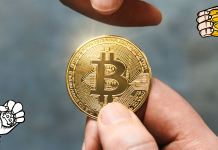You’re a proud cryptocurrency owner, thanks to your stellar crypto gambling skills on the best crypto casino.
So, naturally, you’ll want to know all there is to know about fungible and non-fungible tokens, or NFTs, and how they are applied to gambling and smart contracts. Luckily, this blog gives you the low-down on all the important buzz terms.
To provide some background knowledge, we look at the difference between a fungible and non-fungible token, also known as an NFT.
Then we will briefly consider some of the features of the largest NFT standards before we explore how to trade and buy them. We will discuss the broader significance of NFTs in the blockchain world.
First, What Is A Token?
In the broader context of things, a token is a tangible representation of something intangible, whether a quality, fact, accomplishment, etc.
To explain this more clearly, here are two examples to consider. A token could be:
- A driver’s license represents the training and skills you acquired before being allowed to drive in your region.
- A student card that represents the fact that you are a registered student at a learning institution.
Tokens In A Blockchain Context
A token can represent just about anything within a particular crypto ecosystem or blockchain. It could be a stake, value, or even a voting right. And it doesn’t have to represent just one thing either; it can take on multiple roles.
Examples could include:
- Currency tokens that are used for transacting within a blockchain ecosystem.
- A toll represents a gateway to a decentralised application (Dapp) within a blockchain where you need the token to gain access.
- Ownership token denotes ownership over something unique, like virtual collectables.
- Voting rights, as found on the EOS network, where token ownership gives you the authority to vote for block producers.
- A value exchange where tokens represent the value of something, allowing for an internal ecosystem to be nurtured within the blockchain application.
The Difference Between Fungible and Non-Fungible

Fungibility is all about how interchangeable one asset is with another asset of the same kind. Money is fungible; consider this example: if you borrow $10 from your brother, you don’t have to give him back the original $10 note. Any $10 will do.
In this sense, dollars are fungible. They can be interchanged for one another without this exchange influencing their value.
Now let’s consider a non-fungible asset. Imagine your sister borrows your laptop for an evening and gives you back a different one when she is done. You would have every right to be upset because this is an example of a non-fungible asset.
You cannot exchange one laptop for another without fundamentally altering its value. In this example, the laptop is a collectable asset, and we can classify all collectable assets as non-fungible.
Fungible vs Non-Fungible Tokens
So, now we better understand what a token, fungible, and non-fungible mean. Let’s directly compare a fungible token with an NFT using the following characteristics:
- Interchangeability: You can exchange a fungible token for any other token of the same kind, just as you can use any $10 bill to replace a borrowed $10.
An NTF, on the other hand, cannot be exchanged for another token of the same kind. If you lend someone an NTF, they must return the SAME token to you to preserve its value. Just like in the laptop example.
- Uniqueness: Fungible tokens of the same kind are all identical to one another. In other words, fungible tokens are uniform.
An NFT is unique to all other tokens of the same kind, contributing to its value.
- Divisibility: A fungible token can be divided into smaller units that add up to the same value. Like how you could pay back $10 with two $5 bills.
An NFT is non-divisible. The elementary unit (the smallest possible unit) is one token.
- Token standards: Fungible tokens such as OMG, SNC, or TRX are issued on the Ethereum blockchain using the ERC-20 standard.
NFTs, on the other hand, are issued on the Ethereum blockchain using the ERC-721 standard.

The Major Standards: ERC-20 and ERC-721
You may have heard of standards. In really simple terms, these are sets of rules governing a token’s supporting architecture to ensure it can interact with other tokens.
An NFT is built on the ERC-721 standard. But, this standard is very similar to the ERC-20 standard. The design similarities were deliberate to allow developers to easily transition to the new standard while allowing users to store NFTs in regular wallets for trade on major exchanges.
ERC-20
We will quickly look at the original ERC-20 standard as it has similar underlying elements to ERC-721.
This particular standard is made up of various elements, including:
- totalSupply
- approve
- allowance
- balanceOf
- transfer
- transferFrom
In addition, they can also have a token name, a token symbol, and an associated decimal up to 18, as seen in the Ethereum ecosystem.
ERC-721
An NFT, on the other hand, is created using the ERC-721 standard. This uses two additional elements to keep track of the following functions:
- ownerOf function: This function queries the token owner
- transferFrom function: This function transfers ownership of a token
Other NFT Blockchains
While Ethereum’s ERC-721 standard was the original NFT producer, other blockchains have started producing their own standards.NEO, EOS, and TRONS are the next largest platforms to have jumped on this technology.
Token Ownership
When you buy fungible tokens such as ERC-20 tokens, two things need to be included in the smart contract.
One is the right of ownership.
The other is the amount each party has after the transaction.
With an NFT, you must also specify the token’s unique ownership details, as each is different and holds its value.
A transfer of ERC-721 deals with two unique events, which are fired whenever called upon by a contract. This, in turn, causes external programs to execute the necessary code. These events include:

1) Transfer event: Fired whenever a token changes owners. This event details which account sent the token, which received it, and the exact token that was transferred (token ID).
2) Approval event: This is the second event that is fired. It details the account that currently owns the token, the account with permission to hold it after the transfer event, and the unique token ID.
Buying and Trading Non-Fungible Tokens
Currently, you cannot trade NFTs on cryptocurrency exchanges. They are bought and sold in their unique digital marketplaces, including Openbazaar or Decentraland marketplace.
Various NFT marketplaces sell valuable digital collectables, including Rarible, OpenSea, and Enjin Marketplace.
Popular Categories
- Digital Collectibles: These acquire value because of their scarcity. Terra Virtua is the largest digital collectable company creating NFTs today, which creates collectables inspired by big brands and Hollywood.
- Digital Art: The leading distributor of digital art using NFTs is SuperRare, which has traded over 11,000 artworks.
- Gaming NFTs: Decentraland is the big name here, trading in virtual goods such as unique gaming skins.
- NFTs and DeFi (Decentralised Finance): Aavegotchi is an experimental start-up using NFTs to create a DeFi money market.
The Significance Of The NFT
Right now, non-fungible blockchain standards are still in their infancy. But once the technology takes off, it will mean that any type of asset can become tokenised for representation on a blockchain.
Blockchain technology will only become more prevalent due to its many advantages. Above all, blockchains are lauded for their decentralised nature and the security and immutability with which transactions can occur. Now apply those characteristics, which helped cryptocurrencies flourish today, to almost any other asset you can think of.
Any unique digital asset could be differentiated from others, and in doing so, the value or scarcity of the asset could be proven. For example, this is likely to take off in the digital artwork industry.

A blockchain network could issue things like degree certificates, ownership licenses, and driver’s licenses. The result would be a digital document that could be recognised and validated worldwide.
NFT smart contracts allow for detailed characteristics of the assets to be included over and above owner identities, such as rich metadata or file links.
In gambling, non-fungible tokens are prompting rapid data processing and asset digitisation. They are marking unique assets that aren’t recognised in disparate systems, giving gamers more power and ownership.
When you think about it, the possibilities are endless with this kind of technology entering the scene.
The Takeaway
Blockchain technology is more than likely going to play a massive role in the future. We think of blockchain technology mainly in the light of fungible cryptocurrencies. But imagine the possibilities associated with tokenised non-fungible assets.
Tokens can be created to represent not just currencies but also other types of assets.
NFTs are one of the new frontiers of blockchain technology, and as such, they deserve our attention!















